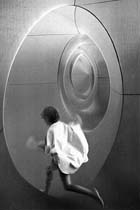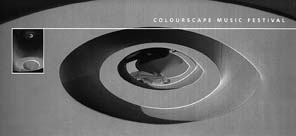
Colourscape |
NAKATANI Masahiro (architect) | |||||||
Colourscape |
| Colourscape was conceived by the English artist Peter JONES in 1965 as a membrane-like structure composed of various chambers with a succession of ever-changing, ultra-brilliant colors. It was, you might say, a color sculpture that people could walk around inside of. Each of the Colourscape structures have varied according to the size, function, and name of the project. In the past, project names have included "Hub," "Wing," "Mirror, Mirror," and "Festival." These have ranged in size from roughly 1200m2 to 2900m2. The color of each chamber is arranged to create a space that is appropriate for a variety of human activities, and the brilliance and changes in color are designed to call up some primordial human sensation. Upon entering, each visitor wraps their body in a red, green, yellow, and blue cape. This is intended to make each visitor a colored, moving object that becomes a part of the interior environment and also to make them a part of the color experience of other visitors. The light sources inside are purely natural and enter via semi-transparent PVC (polyvinyl chloride) membrane that have been colored with primary hues. Yet the blend of colors created has the beautiful shine of an aurora, which is hard to believe especially after viewing the slightly silly appearance of the structure's exterior. Inside "Colourscape," color is so all-encompassing that people seem to have been swallowed up by it. The experience might be compared to being totally surrounded by an aurora or pieces of stained glass with rays of light hitting them. But "Colourscape" is something that most people have never before experienced. The project, which began as "Spaceplace" in 1965, now takes place as a kind of collaboration between the group and the event organizer. This is due to the fact that special measures must be taken at each event to meet the requirements of the site and the wishes of the organizer. At the same time, the project has branched out to create a variety of events from workshops and other educational programs to performances and music festivals, and has developed into a project that can be enjoyed by a great number of people regardless of age or sex |
 |
Colourscape Workshops |
In workshops given by the group, questions such as "What exactly is color anyway?" are discussed with children based on their experiences inside "Colourscape." How well could an adult explain themselves when asked to reconsider color anew? How many colors are there? Inside "Colourscape," it is possible to discover colors and light that would be difficult to conceive of in our daily lives. The workshop is designed to assist in these discoveries while also guiding participants toward methods of expressing discovery and surprise. By expressing discovery and emotional sensations in words, poetry is born; by expressing them in sound, music is born. If you used your hands, it might turn into a painting or sculpture, or some people might choose to use their whole bodies to express themselves in a dance-like form. Through color, Colourscape hopes to bring out the talents and possibilities children hold within them. |
 |
Colourscape in the Venue |
| In this way, Colourscape takes elements of an event and tries to contribute something to the local community. But the characteristic of their educational programs and collaborations with local artists is the work they do in a particular community. As an example, I'd like to introduce the group's projects in Aberystwyth in South Wales and Clapham Common in London. The following is based on some letters I received from Peter Jones. |
Aberystwyth |
| Lynne DICKENS and I first visited Aberystwyth when Colourscape did a showing at the art center there in May 1982. The light in the sky and the color of the sea were unfailingly beautiful, and Colourscape was well received there. In the summer of that year, we received another invitation to show there, this time for an extended period. The aim of this "Colourscape" was to make the plaza that lay between the art center and university come alive. The showing proved to be extremely popular, which resulted not only in high praise for Colourscape, but also for the art center itself. During the time it was held, I met with area artists and performers who told me that they were in the process of creating a working center. A building that had fallen into disrepair in the heart of the city had already been proposed as the location and negotiations were in progress. We had been involved in a community art project in London in the 70s, so the idea didn't seem especially new to us. But we were enthused by their zeal, the beautiful landscape of South Wales, the light of the sea, and the natural light that poured regularly into the large studio, and decided to relocate to Aberystwyth. As the studio had been used in the past as an iron foundry and a pharmaceutical factory, large-scale renovations were necessary. But as these were being completed, we observed the color of the sea and the light, and eventually we were rewarded with a 2000-square-foot, bright space with high ceilings. At the same time, we did Colourscape projects, we worked together with others in drama productions, dance, movies, schools, and science projects. Among these were RIBA's "Architects in Schools," "The 3rd Policeman Color Conference," and LEA's "Spring into Color." When the center opened, the building and we ourselves became known as Canolfan Yr Sgubor (Welsh for "The Barn Centre"). It soon gained a reputation for its cutting edge community art projects and the high quality of the center itself, and became recognized as a model for similar projects in England. However, the local council, who owned the building and was made up of influential members of the community, failed to realize the value of the project, and eventually opted to close the center in order to "develop" the area. The closing caused unmeasurable grief for many people in the town because it had encouraged creativity in their daily lives and given the local people a taste of the happiness of creation. |
Clapham Common |
I first came to know Simon DESORGHER and Laurence CASSERLEY when we worked together on the premier of "Ourdissian," a never before performed work by Sadowsky, for which they had requested a Colourscape structure. Both musicians, the two had visited Colourscape in 1983, and conceived a new form of musical drama. The first performance of their musical drama "Labyrinth" was given in 1989 on the South Bank of London's Thames River with musicians, dancers, and mimes dancing through Colourscape's "Hub." They were also the producers of the annual avant-garde music festival at Nettleford Hall in South London. After the success of our collaboration with them, they had the idea that this festival would be the perfect place for Colourscape. So since 1989, "Colourscape" has been held at Clapham Common. This project, now called the Colourscape Music Festival, has become a well-established event through a collaboration with the general public and the participation of area schools. We work with university students and 2,000 school children every year, and have a special educational unit based at Clapham Common, which sends out composers and artists to the schools to have the children make music for musical dramas, which are then performed at Clapham Common. This spectacular program will lead to the expansion of the festival into an even wider area in 1998. For the gradual maturity of this idea, which began in 1989, to blossom, it has been necessary to receive economic support along with the support of enthusiastic people. Behind the success of Clapham Common lies the strength of the Lambeth Borough Arts Team, who have provided a site and the infrastructure at no cost each year, and supported the event through publications and other activities. It is extremely unfortunate that the Arts Team has now been discontinued by the Borough due to economic downsizing, but I remain confident that Colourscape and the Colourscape Music Festival will continue with the passion and understanding of people in the community without having to rely on politicians or others in positions of authority. As you can see from the two examples above, Colourscape has developed steadily along with the relationships they value so much with people. Not only is the attraction of Colourscape one of physical beauty, it lies also in the kindness and richness of these relationships. Since last year, Colourscape has been preparing to visit Japan. There is a wide gap that must be bridged between the Japanese and English sense of time and other systems, but at last it has begun to look possible in 1998. I would like nothing more than to see the realization of this plan as soon as possible, and would welcome any interested persons to contact SoundArts. |
| Photographs courtesy of Colourscape & the ColourscapeMusic Festival. |